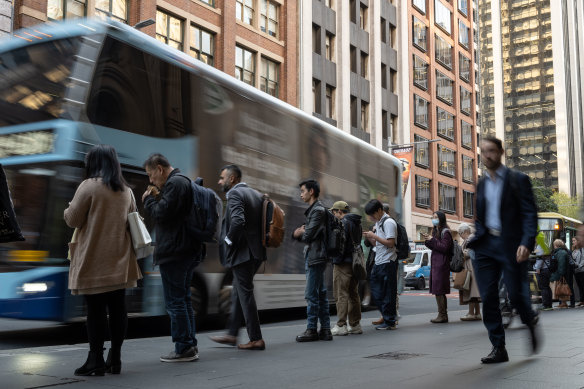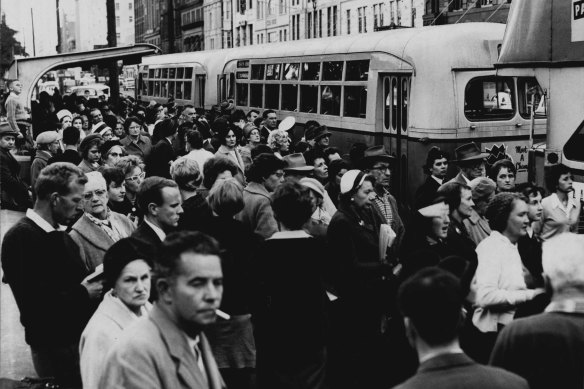Opinion
Hell hath no fury like my cancelled bus. Time for Minns to get on board
Alexandra Smith
State Political EditorThere were unseemly scenes at my Randwick bus stop on Wednesday. As a jam-packed 377X sailed by, and the next service was cancelled, tensions ran hot at 8am. I half-expected a brawl to erupt as angry commuters and students elbowed each other out of the way to get on the next bus which, as the flustered driver warned, could only take a few of us. A handful made it on, leaving others to fume as they wondered whether another bus would even turn up.
This is not a new or one-off experience. Bus cancellations, late services and overcrowding are a Sydney-wide problem that has long been wearing down commuters. One of the many reviews that Labor initiated when it came to power in March involved the bus network.

One of the many reviews that Labor initiated when it came to power in March involved the bus network.Credit: Wolter Peeters
A taskforce, led by former bus supremo John Lee, was established to uncover the troubles with the network. This week it released a white paper and is seeking passenger feedback on “on-street transit”. A rapid bus network, similar to the popular B-line turn-up-and-go service to the northern beaches, could be an option to improve life for commuters. But while the government continues down the path of reviews, the problems and commuter anger remain.
The Minns government has shown it is adept at finding problems. As a newly elected government, it spent its first months in power highlighting the headaches left by the Coalition. But as the election year nears its end, Labor will no longer be a rookie government. Solutions must replace problems.
The teacher shortage crisis crippling public schools would be a good start. Ahead of Education Minister Prue Car’s first appearance before budget estimates on Tuesday, the government released damning figures about a big problem for the state’s classrooms.
It was a political tactic designed to get on the front foot. Car and her team wanted to heap all the blame on the former Coalition government for the chronic shortages facing NSW, where there is a weekly deficit of 3000 casual teachers. This means, according to Labor, about 10,000 lessons every day are left without proper teaching or supervision.

It was ever thus.Credit: Staff photographer
But teacher shortages are deep-rooted and exist around the country. It is not a problem unique to NSW, although the state Coalition was clearly unable to resolve it during its 12 years in power.
On Tuesday, as Car was quizzed by her predecessor, she seemed more focused on the problem than the solution. She was insistent that paying teachers more would be the silver bullet to attract more staff to fill thousands of vacancies. Labor, to its credit, managed to deliver a historic pay rise for the vast majority of teachers in NSW, which the former government was not prepared to do. This will undoubtedly make the profession more appealing.
However, beyond paying teachers more, Car did not explain where she would find the additional staff to plug the worsening gaps. Instead, she pointed the finger at ex-education minister Sarah Mitchell. Car seemed to forget temporarily that she is the one in charge now.
Public transport, particularly the troubled bus network, also needs the government to shift its gaze from the rearview mirror. During the election campaign, Labor zeroed in on the problems – substandard services and a chronic lack of drivers – to highlight the impacts of privatisation on essential services. Labor has persisted with this theme since its March victory, but now it is its problem. And voters are impatient.
Long-time ALP hardheads have observed that NSW Labor’s regime is adopting Bob Carr-style tactics. That is, create a problem – or at least highlight one – so you can solve it. But with that comes the risk that a government operates like an opposition. This is happening with the Minns government.
One of the key reasons for the Coalition’s loss in March, as identified in the NSW Liberals’ election post-mortem, was the “it’s time” factor. Other matters did not help, such as party infighting and the ghost of Scott Morrison tarnishing the Liberal brand. But a compelling force was that voters decided the Coalition had had its turn in NSW. It was time to give Labor a chance.
Labor prevailed by convincing enough voters that the Coalition had left NSW with a host of headaches. Highlighting those problems is one thing. But as Sarah Mitchell pointedly reminded Car – and Labor – this week: “It’s your turn now.”
Alexandra Smith is the state political editor.